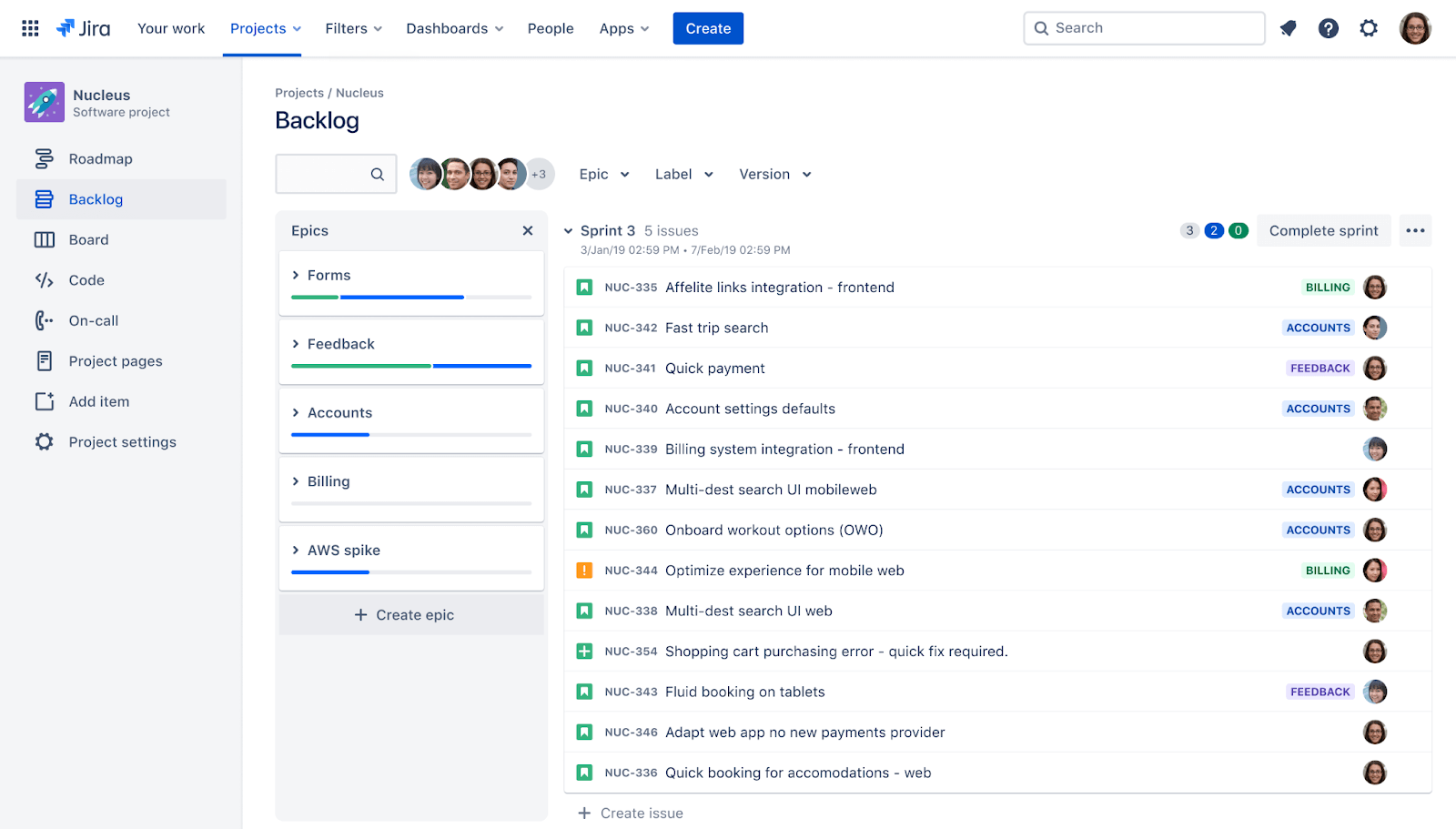Cultivating an agile mindset
How to get your team to love and adopt agile methodology

Get started with the free agile roadmap template
Streamline your project and easily plan, track, and manage work across sprints.
Key Takeaways
An Agile mindset emphasizes collaboration, learning, flexibility, and continuous improvement for high performing teams.
Core pillars include respect, optimized flow, innovation, and relentless improvement.
Adopting an Agile mindset empowers teams to adapt to change and deliver better results.
Foster an Agile mindset by encouraging open communication, experimentation, and regular retrospectives.
Imagine an outdoor summer concert — you probably picture a relaxed, comfortable, enjoyable atmosphere. You attend this concert with an expectation that the musicians will riff off of each other and harmonize in real-time.
However, as soon as the performance begins, everyone on stage plays in separate keys in an uncoordinated manner. This wouldn’t be a very good performance, and more than likely you would feel frustrated with the turnout of the event.
Now take this scenario and apply it to the workplace.
A team cannot function properly without some form of structure. In the same way that music relies on melody, harmony, and rhythm, a team needs a strong underlying system to achieve a common goal. Constraints are often seen as limiting and hindering when in reality, they complement each other to provide a team with true project flexibility.
In an agile work environment, the strong underlying system of guidelines offers teams the agility to optimize their work for improved and more efficient delivery.
Continue reading to discover how to help your team learn and adopt the agile methodology — starting with the right mindset.
The agile mindset
The agile mindset is a thought process that involves understanding, collaborating, learning, and staying flexible to achieve high-performing results. This way of thinking helps teams adapt to change, rather than struggle around it. Instead of simply diving into agile practices and going through the motions, it is vital for all team members to understand and truly adopt the methodology in all aspects of their work. When the ‘why’ of agile is clearly understood, the ‘how’ is nurtured naturally in accordance with the needs of the team.
It’s no secret that change is hard and can be difficult to navigate, especially with complex projects. Making even the slightest adjustments to existing systems can often feel tedious and not worth the effort. Studies show that 60-80% of project failures can be directly attributed to poor requirements gathering, analysis, and change management. The agile mindset is the perfect approach to these turbulent and challenging environments as it teaches how to embrace change, rather than continuously avoid it.
The intention behind an agile mindset is to empower your employees to do their best work. A strong mindset allows team members to experience autonomy, freedom, creativity, and innovation. The result is a happy and healthy team, which in turn continuously improves the strong system in place.
The four pillars of the agile mindset
The four pillars of the agile mindset
The goal of agile is to shift your team from an isolated island among waterfall processes to a thriving system that knows how to ride the tides of a workplace that must quickly adapt to customer demands and the evolving market. But even with the right methods and tools, an organizational mindset won’t simply shift on its own.
The core values of the agile mindset welcome change with agility and flexibility, which takes time to implement. While there are no specific rules to adopting an agile mindset, there are four key pillars that make the process smoother and help your team foster a thriving environment.
Respect for all team members
The most important pillar to keep in mind is that the people on your team are absolutely essential to the success of the organization. Working with your team as a collective unit unites everyone with a common vision, purpose, and goal. Team members who are treated with respect naturally gravitate towards delivering continuous, sustainable, and value-packed results.
Fostering a culture of respect and psychological safety, the belief that you won't be punished or humiliated for speaking up with ideas, questions, concerns, or mistakes, is one of the most effective ways for teams to achieve an agile mindset. With meeting the customer’s changing needs being the driving force behind the need for agile, it is critical for everyone on the team to feel safe taking risks and being vulnerable in front of each other.
This mindset creates a positive and safe workplace where everyone is empowered to evolve in their agile practice. Even more so, team members feel valued and included as part of the process, instead of perceiving themselves as just another cog in the machine. A great way to encourage this is to create open pages in Confluence to keep everyone on the same page — literally! Open pages are the default in Confluence. Open pages allow everyone in the organization to not only be informed about the information, but also contribute to the vision of the project.
TIP
Draft a blog post to help your team understand how adopting an agile approach benefits the organization as a whole.
Employees need to see managers walk the talk and embody ‘we’ instead of ‘I’. In other words, mutual respect throughout the organization is essential to truly create the vision of agile. Modeling collaborative behavior, admitting mistakes, and encouraging improvement contributes to a strong system and delivers a successful and evolving practice. A lack of collaboration leads to a lack of productivity. The agile mindset combats this by truly encouraging everyone to work with each other and equally contribute to the project.
Optimized and sustainable flow
An optimized workflow refers to the implementation of incremental delivery, reduced batch sizes, and continuous improvement. The agile mindset builds in quality by allowing teams to maximize value and minimize waste. It’s a lot easier to fix an issue as it occurs, rather than at the end of the workflow. For example, think about the flow like painting a house. If you paint one wall the wrong color, it won’t take much time to re-paint and fix the problem. But if you paint the whole house the wrong color, the issue increases dramatically and results in a lot of time and energy wasted.

The agile mindset helps your team avoid start-stop-start delays and catch these defects in the early stages before the product is deployed. Your team will respond much more efficiently to reliable and consistent releases, rather than being forced to redo large batches of work in the case of deficiencies. In short, consistent responses and fast feedback allow your team to make adjustments accordingly and avoid major delays. An optimized and sustainable workflow will be the difference between an exhausted and overworked group, and a thriving, collaborative, and agile team.
Encourage team innovation
Innovation is the driving force of a team with an agile mindset. Allowing your team to provide collaborative and constructive feedback, new ideas, and different approaches opens the door to experimentation that could transform your culture as a whole.
One of the most prominent benefits of the agile approach is how much autonomy the team members have during a project. When people are given the freedom to find new, improved, and more efficient solutions to their tasks instead of simply being told what to do, innovation thrives. As a team leader, it’s important to provide ample time and space to nurture your team’s creativity and ability to think freely.
For example, the Confluence brainstorming template is a great way to collectively share ideas and showcase the opportunity for innovation to thrive. In this collective approach, everyone has an equal opportunity to contribute their thoughts. Additionally, feedback and constructive input from the team could result in thought processes that haven’t been voiced before, encouraging the agile mindset to thrive among your team members.

Focus on relentless improvement
The agile mindset isn’t something that teams achieve, but rather something that is continuously cultivated. Teams should strive to find ways to optimize, problem-solve, reflect, and continuously improve in the process. Along with collaborating, optimizing the workflow, and encouraging innovation, teams should implement retrospectives, or periods of reflection, to improve future processes.
Creating a cadence between structure and innovation sets the team up with expectations, while still maintaining the freedom to explore different ways to improve. Teams should meet regularly to check in with each other, make adjustments as needed, and ensure all members are still on the same page with the agile mindset. Continuous delivery will be successful when your team’s feedback and improvements are incorporated into the ongoing process.. This brings the agile mindset full circle and creates action to improve the results.
When focusing on relentless improvement, a team should determine the root cause of the problem and work on solutions immediately. By using tools, such as Jira and Confluence, you can easily organize the workspace and techniques needed to implement a solution.
Tools help you streamline agile processes, so your team can focus on solving problems and moving forward with ease. As your team continues to improve their agile mindset and practices, these tools accommodate every stage of their growth and workflow needs.
How to use Confluence and Jira to achieve an agile mindset
When teams have their own unique ways of getting work done, it’s critical to implement a space where everyone can stay aligned. A strong system helps to cultivate optimal team performance and make your agile practice much more successful. By taking advantage of tools that are specifically designed to accommodate your agile needs, teams have the enhanced ability to collaborate, coordinate, and contribute throughout the entire project. With the right agile tools, your team will have everything they need to reach their full potential.
We recommend this dynamic duo: Confluence and Jira. Confluence creates a shared, open space and pages for the entire team to contribute and collaborate on the vision, goals, and performance of projects. Jira unlocks the power of agile with flexible planning, transparent execution, scalability, and so much more. Together, they are the bread and butter of successful agile teams.
Utilizing these tools creates a direct relationship between performance, quality, and project success. These tools offer a seamlessly integrated solution to all development needs. Confluence and Jira take care of optimizing the work processes so that your team can focus on nurturing and building a true agile process together.
Excited to get started with agile? Check out Jira templates for every team in your business.
Recommended for you
Templates
Ready-made Jira templates
Browse our library of custom Jira templates for various teams, departments, and workflows.
Product guide
A comprehensive introduction to Jira
Use this step-by-step guide to discover essential features and the best practices to maximize your productivity.
Git Guide
Understanding the Basics of Git
From beginners to advanced experts, use this guide to Git to learn the basics with helpful tutorials and tips.